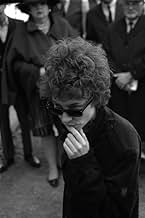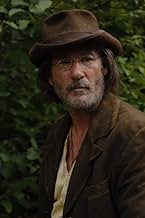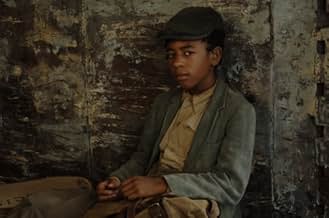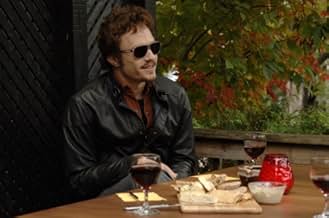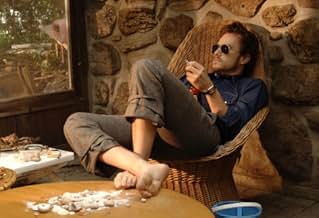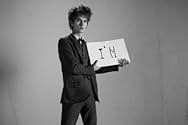Grübeleien über das Leben von Bob Dylan, präsentiert von sechs verschiedenen Figuren, die jeweils einen anderen Aspekt im Leben und Werk des Musikers verkörpern.Grübeleien über das Leben von Bob Dylan, präsentiert von sechs verschiedenen Figuren, die jeweils einen anderen Aspekt im Leben und Werk des Musikers verkörpern.Grübeleien über das Leben von Bob Dylan, präsentiert von sechs verschiedenen Figuren, die jeweils einen anderen Aspekt im Leben und Werk des Musikers verkörpern.
- Für 1 Oscar nominiert
- 29 Gewinne & 49 Nominierungen insgesamt
- Narrator
- (Synchronisation)
- Hobo Moe
- (as Roc LaFortune)
- Circus Man
- (as Brian RC Wilmes)
Empfohlene Bewertungen
FIRST and famed-mostly, Dylan was a "Rock Star". This period is played out by Cate Blanchett as "Jude Quinn". This character sports a fictitious name, but like much of the movie, comes (not from McCartney's "Jude" but) obviously from Dylan's oeuvre - the Christian "Jude" and "Quinn the Eskimo". This Dylan has the clearest Beginning and End points of any. He was "born" when startling his folk audience by "going electric" (guitar) and "dies" in a motorcycle accident at the peak of his fame.
SECOND most famous, and highly influential, Dylan was the "Folk Singer" replaced by the above. Here, it's Christian Bale as "Jack Rollins". This Dylan was quite popular on his own, but was much "covered" by other folk artists and rock bands. During this time, Dylan was more like a very big cult, and his songs were more widely heard when other people made hit records from them. The songs were more Political (protest) during this time, getting vague later (with exceptions, like "Hurricane").
THIRD time around for Dylan was his "Cowboy" persona, essayed herein by Richard Gere and named "Billy the Kid" after the outlaw anti-hero Dylan play-acted. This was the Dylan emerging after the motorcycle accident. Dylan left a bunch of unreleased tracks (known as "The Basement Tapes") and "reinvented" himself as a more countrified mellow rocker (listen to "Lay Lady Lay"). Here, the "stages" of Dylan's art become more blurred as he no longer commanded the attention he did earlier.
FOURTH biggest change, after a long run without defining boundaries, was the "Born Again" or "Christian" Dylan. This startled some people, but (as the film points out) it shouldn't have been unexpected. In fact, the "Fame"/"Drugs"/"Jesus" continuum is very common among music stars, as anyone watching MTV's 1990s biographies could plainly see. For this film, Mr. Bale (uniquely) plays two Dylan incarnations, revising his earlier "Folk Singer" character "Jack Rollins" to become "Pastor John".
BUT, that's not all. There are three less public parts of the quadraphonic Dylan covered by Mr. Haynes
FIRST is Dylan's mysterious boyhood masquerade as "Woody Guthrie" played by Marcus Carl Franklin. He is the kid on the train, sporting the Fascist-Killing-Guitar-in-the-West. Of course, Woody Guthrie was a real person, and he had a tremendous influence on Dylan. While cute and well done, this section is not revelatory, which could be why the film project had "the real" Bob Dylan's blessing. The real Dylan, who appears briefly near the end, did not appreciate biographers peeking into his personal history.
SECOND is Dylan "The Poet" named "Arthur Rimbaud" and played by Ben Whishaw. Like the above, but more of a conglomerate, the character is a real French poet named Arthur Rimbaud who influenced Dylan (and many other rock stars). The Dylans are presented in sort of an overlapping chronological order - which may not make sense to the uninitiated - but this one is used more like a muse for the others, accentuating Dylan's reputation as a true "Tarantula" of a Poet, even without the music.
THIRD and perhaps most esoteric is Dylan "The Actor" played by Heath Ledger as "Robbie Clark". Dylan did do some movies. Mortals do not forgive. Even an epic focusing in his relationship with a certain sad-eyed of the lowlands. Rather than show Dylan acting in a movie, this "Actor" section perversely shows the more camera-shy Dylan. It seems highly fictitious, but you've got to appreciate "Dylan" telling what looks like "Patti Smith", "chicks can never be poets." (!) And, "I Want You" is a terrific vignette.
In sum, "I'm Not There" is an excellent film for obvious believers, with minus zero insight into its subject. Bobby Zimmerman could hardly disapprove. By the way, the fact that the vinyl "Stuck Inside of Mobile with the " was amusingly continued in the "Blonde on Blonde" gate-fold jacket as " Memphis Blues Again" is no excuse to edit the song. And, changing the lyric, "Here is your 'throat' back, thanks for the loan..." to "Here is your 'mouth' back, thanks for the loan..." really sucks. Moreover, it's sacrilege.
******* I'm Not There (9/3/07) Todd Haynes ~ Christian Bale, Cate Blanchett, Heath Ledger, Richard Gere
The much-publicised, overly re-hashed concept driving the film is this: Dylan is portrayed by six actors of different races, ages and genders, none of whom are named Dylan, but represent aspects of his personality and life story. Every art-house buff will squeal at this delightfully off-kilter concept (well, except that it's been done before) - but never used so cleverly I'll admit. But, the cleverness of the concept only remains clever if it is executed well. This is where most people have a problem with the film.
Most of what you may have read in reviews is correct. The film is challenging, borderline plot-less (unless you are generally acquainted with Dylan's life) and seems muddled (again, only if you don't have a general knowledge of his life). For anyone who can't grasp the basic, "each actor represents a stage etc." concept, this film will be lost on them completely... because it gets even more complicated! The film is so layered, with hidden in-jokes, and snippets of real quotes from songs and interviews with Dylan used as dialogue, and story lines within story lines. A great example is Heath Ledger's character: Ledger (an actor), plays an actor, playing Jack Rollins in a biopic, who is the representation of folk-singer-Dylan (a stage). An actor in a biopic playing an actor in a biopic about a singer representing Bob Dylan played by an actor in a biopic. The self-parody is just hilarious in this film.
To add to these 'layers', each actor's "stage" that they represent is filmed in a distinctive cinematic style, for example, the Cate Blanchett as Jude Quinn representing Bob Dylan sequence is shot in lush black and white. Haynes relishes this opportunity to show off, and he does. The film is stylistically stimulating, even if it does drag sometimes for ignoramuses like me who know literally nothing about Bob Dylan.
For those questioning the film's intentions as a biopic, I should think it was really obvious! The opening credits give a huge clue, as the main title comes up in stages: "I", "He", "I'm he", "I'm her", "Not her", "Not here", "I'm not there".
The film is like a dream: you come out of it with this vague (exact details in the film are scarce) and vivid impression of Dylan's personality, without learning anything. The title is certainly relevant - Haynes' actually conceals Dylan in this film! This biopic is conventional in the way it still presents a chronological life story if you arrange it all together and remember the actors represent one person, but it is different in the way it doesn't try to make a real person into a character for a film. This is really the only way to represent someone - by not.
This film is composed of stories and individual representations and metaphors that describe a person's life, their attitudes at points in time and aspects of their personality, but gives us nothing. Absolutely nothing.
So, if you're ready to put the level of effort and concentration required to appreciate and maybe like the film, go for it. But I was not prepared for this film and I wish I'd read a biography before I saw it. That said, not knowing anything did help in a way, as after we had several questions about events in the film and their basis in reality. After all, the trailer had told us that stories were exaggerated, fictionalised, imagined and true. It inspired me enough to look him up on Wikipedia (I know, such dedication!).
The performances are all generally good. Blanchett, Bale and Franklin impressed me the most. Blanchett only falls short because of her voice, but she has the accent correct, and she can't change her voice that much! She became more believable as the film progressed. Charlotte Gainsbourg is also quietly moving in her role as the neglected wife of Ledger's character.
My final opinion is that the film is well executed, but only once you've had time to ruminate on it, research Dylan and hear the director's thoughts on his own work. I read a great deal of reviews as well that helped me to understand (not that I didn't like the film initially; I liked it after I saw it anyway). Appreciation builds the more I learn about the film and the intricate connections between it and it's un-subject.
That said, should a film be this much hard work just to like? Not for some people, but for others, the effort is worth it. It does eventually pay off, but it's exhausting.
The biopicture can be a difficult kind of picture to picture. Even more so when you have no intention of divulging the name of your subject. And dare I say it, yet further still when you insist on casting at least six people to play the lead role. This is the charm behind 'I'm Not There' - Todd Haynes' tribute to the life and times of Bob Dylan that recently lit up the Festival di Venezia. Biographic cinema is a frightening beast, some films are stuffed full of information while others attempt to exactly mimic their respective studies. There are however very few that play with their quarry, flitting from fact to fiction so quickly that in the end we know not what to believe. In reality, the life of Robert Dylan was exactly this mess of lies, grandeur, childishness, arrogance and genius. One of almost unbelievable occurrences that when whispered about long enough become carefully set in stone. Todd Haynes understands this fact and so goes after it with a stance of almost awed respect, yet as an onlooker - crafting a mockumentary that is so rich in character and love and attention to detail that we can't help but be drawn in. I've heard early reviews stating that 'I'm Not There' will make the Dylanites gush and the normal folk sleep. The fact is this couldn't be further from the truth - being a person that is indifferent to the music appears only to heighten the enjoyment.
Somewhere during the last five years, writer/director Haynes came upon the slightly trampled idea of conducting a Bob Dylan biography movie. Nothing original in itself, though with one idea to make it slightly different from what the likes of Scorsese had attempted a few years back. He would use multiple actors for 'I'm Not There', six in fact - to portray the iconic figure. And what an inspired decision it is. The unrecognisable and slender form of Cate Blanchett steals the show, melting into her eye-rubbing, nose-twitching, lip-conscious take that is only too quick to lash those in proximity with a witful tongue. Almost as idiosyncratic is Ben Whishaw's sarcasm-laced drawling poet Dylan. Who prompts guffaws when tiresomely declaring his name as "R-I-M-B-A-U-D" to an arresting police officer. The eccentric duo are displayed primarily in overexposed black and white, and complementing this in Technicolor are the equally impressive Christian Bale and Heath Ledger. Whom fall upon the unwashed, shaded rocker Dylan with equally strong performances. To complete the musical sextuplets are Richard Gere and the delightful Marcus Carl Franklin, these two are the tall-tale Dylans. A jaded western cowboy and a blues-singing black child respectively, both adding another more fictional dimension to the character. They are almost opposite ends of the Dylan-spectrum, and are introduced at the opening and closing of the film to further embolden this point. Franklin in particular impresses, tugging at the humor strings again with his dry recollections of a life on the musical road.
The host of supporting actors/actresses in 'I'm Not There' do well to further the films themes. With Charlotte Gainsbourg and Julianne Moore taking up the posts of drama and documentary accordingly. Each plays one of the two most important women in Dylan's life, with Gainsbourg (Sara Lownds) cooking up a memorable on-screen chemistry - or lack thereof - with Ledger's character. She is instantly attractive across a smoky diner, yet this attraction soon wanes as romance stagnates. Never-ending tours take their toll and the once exciteful, scooter-riding relationship crumbles. Moore's character (Joan Baez) is more reflective, playing her whole part as if interviewed enthusiastically many years on. My only problem is with the later segments of 'I'm Not There'. Particularly those featuring the bearded and bespectacled Richard Gere. Many know the story of Pat Garrett and Billy the Kid, and this part is essential when regarding the plot. My qualm is that it feels almost tacked on as an afterthought, trotting outside the clear themed borders that the film has laid out so meticulously. This only adds to the ballooning length of the film, and so did begin to drag during these Wild-western plot points. That said, this hardly takes away from an experience that is both visceral and enlightening. Comedic and pensive. Wild and tender. A life, in all possible senses of the word.
9/10
Here’s one big problem right off the bat. The six various characters, each representing part of Dylan, have different names. Some of them are named after real-life people, like Woody Guthrie and Arthur Rimbaud. Some have fictitious names, like Jude Quinn (an amalgam of Jude from “Hey Jude” and Dylan’s own “The Mighty Quinn”), Jack Rollins, and Robbie Clark - the latter being an actor playing one of the aspects in a movie. And then it gets confusing.
The first gimmick for this movie is that each aspect is played by an actor you wouldn’t expect to see playing Dylan. Okay, maybe not all of them, but some of them. Cate Blanchett is one. She’s female, in case you were unsure, and she is by far the best Dylan in the movie. She plays Jude, the latter-day, peeved-at-everyone Dylan. Another is Marcus Carl Franklin, who plays “Woody Guthrie” - here, a young version of Dylan, riding the rails across the Midwest. Franklin is African American. Then there’s Heath Ledger and Christian Bale, who are Australian (as is Blanchett) and Welsh, respectively. The problem with those, though, is that the only difference between them and the real Dylan is Dylan’s particular linguistic tendencies, so you wind up with just some guys acting Dylanesque. You know, the perpetual cigarette dangling precariously, the hat, the whole nine yards.
It would have been more effective, for me, if each of the aspects was played by completely different looking people - because in order for them to be identifiable as Dylan, they would have to sound like him. Otherwise you’re left with some folk-singing iconoclast who’s rebelling against everyone, and you don’t know why. So there’s one issue. And that would have been a clever, but not too-clever, way for each supposed aspect or time period to be represented. Even if two aspects were on the screen simultaneously, big deal - at least we could tell who was who.
But added to this gimmick is the fact that some non-Dylan characters - and some situations - are based on real-life people, like Allen Ginsburg, and retain their counterparts’ names, and others are clearly supposed to be real people but have … different names. And some situations definitely did occur (such as Dylan’s getting booed at the Newport festival, a huge turning point for him), but did all of them? Were any of them made up to highlight that particular aspect of his personality? One of the characters is Arthur Rimbaud. No, not the poet, he just has that name. Anyway, the entirety of his screen time is spent giving testimony or something to officials (or a jury, I’m not sure). And his speeches are of the deep philosophical sort, the kind that Dylan was apparently fond of - ways to get into people’s minds, but I’m not sure what the soliloquies add in terms of exposition and revelation.
Then there’s also Richard Gere, who plays Billy the Kid, another “aspect” of Dylan. Apparently here Billy is mythologized as this hiding loner at the end of his career, just sort of like Dylan, only Dylan’s not even now at the end of his career, unless he keels over tomorrow, or something. Gere’s good, and I don’t say that often, but I think the aspect, such as it is, is too abstract and unreadable to be worthwhile.
The intermittent narrator (Kris Kristofferson) is marginally helpful; perhaps he could have been used to tie all these aspects together. Instead we get two hours of ego feeding and idol worship. To me, though, it felt more like idle worship than anything else, a waste of time even if you’re willing to grasp whatever deep insights the film pretends to offer to you.
Wusstest du schon
- WissenswertesTodd Haynes needed to get approval from Bob Dylan to use his music, since (unlike in his Velvet Goldmine (1998) where David Bowie did not give his permission for his music) he felt the film would not work without it. At the encouragement of Dylan's manager, Haynes wrote a one-page summary of his concept and the characters, which Dylan approved. It took another 6 years to get the film made due to funding difficulties.
- PatzerWhen Woody's character is first seen he is running towards a train going North but when he is sitting on the train, it is noticeably going South.
- Zitate
Billy the Kid: People are always talking about freedom. Freedom to live a certain way, without being kicked around. Course the more you live a certain way, the less it feel like freedom. Me, uhm, I can change during the course of a day. I wake and I'm one person, when I go to sleep I know for certain I'm somebody else. I don't know who I am most of the time.
- Crazy CreditsThe way the title appears on the screen at the opening would read: I he I'm her not her not here. I'm not there" (period included).
- SoundtracksGoin' to Acapulco
Performed by Jim James and Calexico
Written by Bob Dylan
Published by Dwarf Music (SESAC)
Produced by Joey Burns
Jim James appears courtesy of ATO Records
Calexico appears courtesy of Quarterstick Records
Top-Auswahl
Details
- Erscheinungsdatum
- Herkunftsländer
- Offizielle Standorte
- Sprache
- Auch bekannt als
- Mi historia sin mi
- Drehorte
- Produktionsfirmen
- Weitere beteiligte Unternehmen bei IMDbPro anzeigen
Box Office
- Budget
- 20.000.000 $ (geschätzt)
- Bruttoertrag in den USA und Kanada
- 4.017.609 $
- Eröffnungswochenende in den USA und in Kanada
- 730.819 $
- 25. Nov. 2007
- Weltweiter Bruttoertrag
- 11.792.542 $
- Laufzeit2 Stunden 15 Minuten
- Farbe
- Sound-Mix
- Seitenverhältnis
- 2.35 : 1
Zu dieser Seite beitragen





